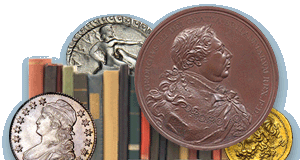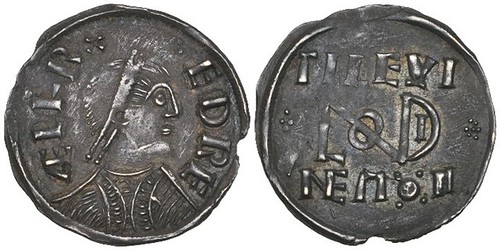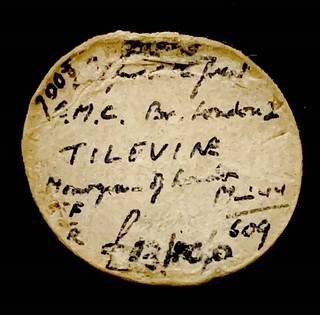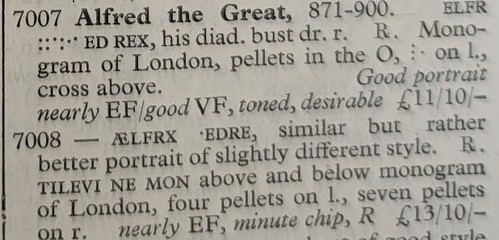
PREV ARTICLE
NEXT ARTICLE
FULL ISSUE
PREV FULL ISSUE
A PIECE OF LONDONIA COINAGE PUZZLEContributor EM submitted this research piece on an elusive London monogram coin of King Alfred the Great. Thank you. -Editor
A piece of Londonia coinage puzzle
In William A. Mackay's famous research on King Alfred the Great London Monogram coinage and its Danelaw imitations (British Numismatic Journal, volume 89, 2019, pages 19-107, further referenced MacKay) the author provides classification of all traceable first pennies and halfpennies issued by the Royal Mint in the name of King Alfred the Great who united England and has taken its capital City of London in the year of 886 A.D. All traceable Danelaw imitations of the said coinage was also classified in this paper. The author stated however that there will be other coins from older collections that will come to light later. London Monogram is a skillfully worked arrangement of the name Londonia designed by the Royal Mint first moneyers in the IX century, and Londonia penny is very frequently shown to the visitors of the Royal Mint Museum. London Type B2 penny has obverse showing King Alfred the Great diademed bust in a neat tunic with concave shoulders (O2). On reverse there is London monogram and cross pattee on each side and the name of the moneyer – Tilevine above and below the monogram (R4). This type was known to W. Mackay from a single coin (MacKay B2 4 Pl. 3, 45) which first came to the market in 1918 at Sotheby's auction selling the famous Carlyon-Britton collection. London Type B3 pennies are known in relatively large variety, including the one with the same reverse R4 but different portrait on obverse – O3 (MacKay B3 5 Pl. 3, 46). In his research on London type B coins (MacKay p. 40) W. Mackay established that O2 obverse die of London Type B2 was later replaced by the Royal Mint with the obverse O3 die of London Type B3, however the reverse die R4 survived the obverse transition thus becoming a link between London types B2 and B3. This is illustrated on Fig.1
Owing great respect to W. MacKay's research, the following question still remained:
was Type B2 obverse O2 used only with the This was a mystery until November 2024 when Morton & Eden brought previously unimaged Alfred the Great London monogram penny (fig. 2) to the market at their auction 129 (lot 18) as a part of the famous Motcomb Collection of British Coins (part III) sold with the old Seaby ticket (Fig 3) dating back to 1944. This coin appears to be the second known of London B2 type with its reverse image unseen before November 2024. It was later on graded AU 53 by NGC and its high resolution true vision image is already available at https://www.ngccoin.com/certlookup/6948283-001/53/
This coin was described by Morton & Eden as of London type B2 (O2/R4var). Its reverse is similar to R4 however instead of cross pattee on each side of the monogram has 4 pellets to the left and 7 pellets to the right, diagonal bar to A omitted. So, the mystery is no longer a mystery and the answer to the London type B2 reverse variety question is definitely YES. We further researched on the provenance of this coin and discovered the following. Mr. Steve Hill – a numismatic specialist and award winning author - discovered a description matching the old Seaby ticket in question in Seaby's Coin and Medal Bulletin No 349 (1947 vol., No 5), June 1947, page 239, inventory number 7008. Seaby did not provide a photograph of this coin, but only the following description shown on fig. 4a and the price of £ 13/10/-. The details of the listing fully match the Seaby ticket on Fig.3 including the price, the Seaby inventory number and World War II period it was acquired by Seaby. Unfortunately Seaby records of that period have not survived and we might never know which collection it came from to Seaby back in 1944. Possibly an even earlier publication of this coin was found by Mr. Leonard Augsburger in Seaby Coin and Medal List No 335 (1944 January-December) , 3822 also without photo, and the description shown on fig. 4b priced at £12/10/-.
It is interesting that only R2 reverse of London types B2 and B3 was known to
present the moneyer's name Televine (sometimes referenced as Tilewine)
interrupted above the monogram and continued below the monogram – TILEVI
NEMON. Also, only O2 is known to have a cross where the name of the King is interrupted – ALFRX EDRE. The newly photographed coin has both of those unique details as described in 1947 and 1944 listings and therefore we suspect that both Seaby publications possibly relate to the same coin in question.
The prices shown on 1944 and 1947 publications
are different, however Seaby warned its customers in advance that the prices to be
shown in their Standard Catalogue of the Coins of Great Britain and Ireland of 1947
will be higher than those in the catalogue of 1945 Both Seaby publications did not publish the photos, which explains why W. MacKay was unable to attribute this coin to any London Monogram type even having had access to those extremely rare Seaby publications. It is amazing that this important coin – a piece of Anglo-Saxon history – has been sitting quietly in the famous Motcomb collection for 75 years until it was first published in Morton and Eden catalogue less than 6 months ago and very recently it's high resolution images appeared on NGC web site. It is now an established fact therefore that London B2 pennies exist in 2 varieties – O2/R2 and previously unseen variety of O2/R2Var. Still W. MacKay's assertion that that the only known link between London types B2 and B3 is indeed the reverse die R2 remains correct as both dies, obverse O2 and reverse R2Var, appear to have retired during the London type B2 period. At the same time the new question shall be asked: since the R4var reverse die is not known to have survived the transition from London type B2 to type B3, was it used prior to the reverse die R4 which has survived the transition? Today, knowing only a pair of B2 type coins we don't have an answer to this. Having a high resolution image of the obverse of MacKay B2 4 Pl. 3, 45 would certainly help to answer this question by assessing (to a certain degree of certainty) which one of the 2 coin's obverse die O2 was worn more, but we don't have access to such image. It may become available in the future, or more coins will be found, and then the London type B2 research will continue. I connected the author to Len Augsburger at the Newman Numismatic Portal. He found the material at the ANS library with the assistance of David Hill. -Editor
Wayne Homren, Editor The Numismatic Bibliomania Society is a non-profit organization promoting numismatic literature. See our web site at coinbooks.org. To submit items for publication in The E-Sylum, write to the Editor at this address: whomren@gmail.com To subscribe go to: Subscribe All Rights Reserved. NBS Home Page Contact the NBS webmaster 
|





